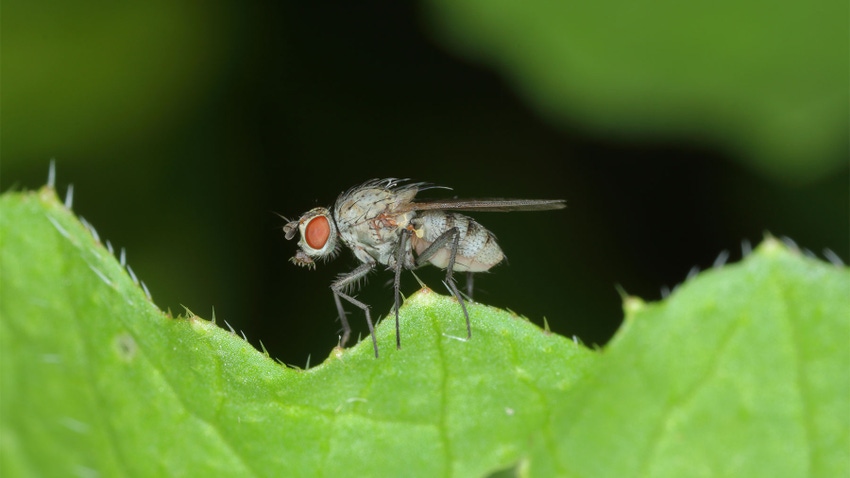August 24, 2023

Looking for alternatives to neonicotinoids? Alejandro Calixto, director of Cornell’s Integrated Pest Management Program, offered a few ideas at the recent New York Corn and Soybean Growers Association’s Summer Crop Tour at Rodman Lott & Son Farms.
“Integrated Pest Management is a science-based strategy that focuses on long-term prevention of pests or their damage through a combination of tactics,” Calixto said.
He believes that a farm is an ecosystem that’s connected to its surroundings, as each area affects the other. But it’s also not a quick fix.
It takes time to address pest issues through IPM, he said. The work isn’t over once a particular issue has been addressed.
“You have to adjust management practices year to year,” Calixto said.
What is IPM? It can include on-farm practices, genetics, chemical and biological controls, and habitat management. The process begins with identifying the pest, monitoring and forecasting those pests, choosing IPM tactics, and evaluating the results of those actions.
Targeting seed-corn maggot
Calixto called the IPM personnel with whom he works with a “SWAT” team of sorts, working against pests such as seed-corn maggot.
Neonicotinoids, introduced in the 1990s, have long been used to try and control this pest of corn.
“They are systemic, absorbed by the plant tissue and move through the vascular system,” Calixto said. “They are water-soluble, taken up by the plant if applied to the soil. They’re the most widely used insecticide in the world, targeting a range of important insect pests.”
But its use has also been controversial, and in New York, state neonics soon could soon become illegal. Earlier this summer, both chambers of the Assembly passed the so-called Birds and Bees Protection Act, which would effectively ban neonic-coated seed from being used in the state. Gov. Kathy Hochul has not signed the bill into law, and it is unclear when she will do so.
For its part, seed-corn maggot is a tough pest because it can easily overwinter. By early spring, the adult flies emerge and reproduce. Females lay eggs in soil by choosing “favorite” places such as soil with decaying organic matter, fields that have had manure applied or have cover crops, and in places where certain legumes are grown. Hatchlings feed on newly germinated seeds, including corn and soybeans.
“There are alternatives and tools, some of which we have developed at Cornell,” Calixto said.
One of those is the use of “blue sticky traps” on farms. Preliminary data from his research, in collaboration with Cornell Extension field crops specialist Mike Stanyard, show that the color of the trap makes a difference.
Last year, Cornell researchers monitored fields for the presence of seed-corn maggots across 61 farms. Data show that the total seed-corn maggot count on blue sticky traps was nearly 500 and just over 100 for yellow sticky traps.
Another neonic alternative showing promise is placing kill traps with lures in fields. Seed-corn maggots are especially attracted to fermented alfalfa, Calixto said, and including this as a lure has proven helpful, in comparison to other lures tested — alfalfa residue, bone meal, fish meal, liquid dairy manure, meat meal and an artificial attractant.
Forecasting when seed-corn maggots will appear can help IPM-minded producers better plan for fighting it. Cornell’s has developed a seed-corn maggot forecasting tool — newa.cornell.edu/seedcorn-maggot — that is currently in beta testing.
“It helps to predict in the fall if you’ll need to order a seed with a treatment,” Calixto said.
Alternative seed treatments
An alternative seed treatment is methyl jasmonate-treated seeds, which induce plant resistance against feeding seed-corn maggots under lab conditions. Preliminary data show a significant reduction in surviving seed-corn maggots.
Other effective alternatives include diamides thiamethoxan, chlorantraniliprole and spinosad. All have been shown in preliminary data to control seed-corn maggots in comparison to plots with untreated seeds.
“No significant seed-corn maggot damage was observed across 16 trials in 2022,” Calixto said.
This year, Calixto’s team is wrapping up greenhouse experiments using methyl jasmonate to determine dose response and crop safety.
“We’re also looking at covers,” he said. “Some cover crops attract seed-corn maggots. There’s not much difference between planting cover crops now and planting cover crops early. So far, we’re seeing a similar pattern this year, and we’re not sure why.”
For next year, the team plans to include new trap designs for field testing, as well as expand the risk tool to include landscape, cover crops and pest pressure history to improve the model; field testing methyl jasmonate and conventional insecticide seed treatments such as diamides and Spinosad; and testing planter-friendly dry treatments of corn seeds with methyl jasmonate.
“We’re going to visit more of you and expand the trapping sites,” Calixto said. “We’re planning a comprehensive economic analysis of these tools, including long-term benefits of adoption.”
About the Author(s)
You May Also Like




